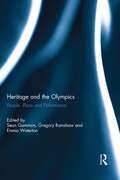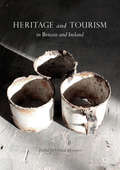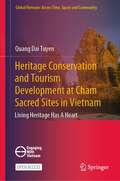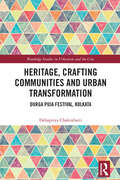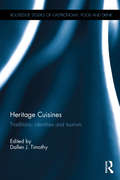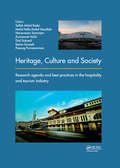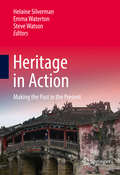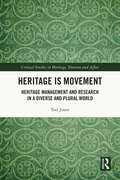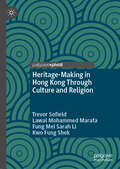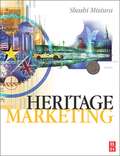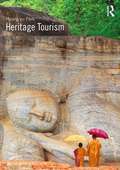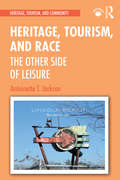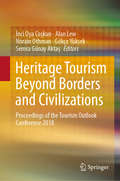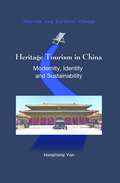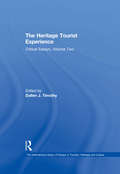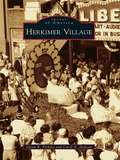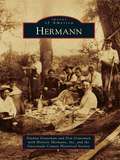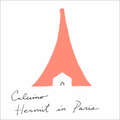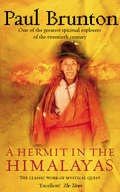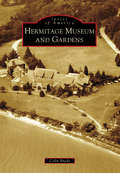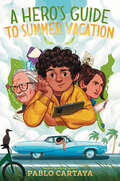- Table View
- List View
Here We Go: Dawn Staley’s Gamecocks and the Road to the National Championship (Sports)
by David CloningerShe stood at the podium on May 10, 2008, and promised to bring national prominence to South Carolina. Most thought it would take a miracle to get to that point, but Dawn Staley has always beaten the odds. Staley’s vision for the Gamecocks’ women’s basketball team came true over the next nine years, culminating in the 2017 national championship. Her willingness to keep striving—to deliver on her promise—was met with early resistance. It paid off with several winning seasons, then terrific recruits. And, finally, the only prize Staley had not obtained in a lifetime of championship basketball. David Cloninger takes you on the team’s journey to the national title.
Heritage and the Olympics: People, Place and Performance
by Sean Gammon, Gregory Ramshaw and Emma WatertonThe Olympic Games have evolved into the most prestigious sport event on the planet. As a consequence, each Games generates more and more interest from the academic community. Sociology, politics, geography and history have all played a part in helping to understand the meanings and implications of the Games. Heritage, too, offers invaluable insights into what we value about the Games, and what we would like to pass on to future generations. Each Olympic Games unquestionably represents key life-markers to a broad audience across the world, and the great events that take place within them become worthy of remembrance, celebration and protection. The more tangible heritage features are also evident; from the myriad artefacts and ephemera found in museums to the celebratory symbolism of past Olympic venues and sites that have become visitor attractions in their own right. This edited collection offers detailed and thought-provoking examples of these heritage components, and illustrates powerfully the breadth, passion and cultural significance that the Olympics engender.This book was published as a special issue of the International Journal of Heritage Studies.
Heritage and Tourism in Britain and Ireland
by Glenn HooperThis edited collection examines the natural, but sometimes troubled, relationship that exists between heritage and tourism. Chapters included focus on a selection of topics, including literary tourism, industrial heritage, conservation and care. Employing a range of historical and cultural materials, as well as an extensive number of case studies, the chapters offer an engaging overview of heritage and tourism developments across the Isles, especially in terms of recent policy and strategy initiatives, new facilities and infrastructure, as well as the different and evolving management systems currently in place. Interdisciplinary in scope, and drawing on the expertise of researchers from within both academia and industry, this volume will be of particular importance to those with interests in management and the humanities.
Heritage Conservation and Tourism Development at Cham Sacred Sites in Vietnam: Living Heritage Has A Heart (Global Vietnam: Across Time, Space and Community)
by Quang Dai TuyenThis open access book considers the growing field of heritage tourism from community perspectives. It explores how the Cham—Vietnam’s large ethnic minority—reconcile their needs for economic development with the boundaries circumscribed by their traditional culture. It examines struggles that local minority stakeholders like the Cham face when trying to participate in areas of development that typically fall under State control. How will tourism affect the ancient sacred spaces that are the Cham’s lifeblood? In what areas is their participation permitted? From what areas are they excluded? Through a novel mix of indigenous methods, participant observation, local voices, and rich ethnographic description, this book provides a rare glimpse into the discourses that have been percolating throughout the community in recent years. The relevance of this study extends beyond the Cham community, and aims to resonate with experiences of the myriad indigenous and minority communities around the world who face similar issues with heritage conservation and tourism development. This book is of interest to students and researchers of heritage studies, tourism management, cultural studies, Asian studies, as well as policymakers, and academicians seeking current research on the connections between culture, conservation, sustainable development, and tourism.
Heritage, Crafting Communities and Urban Transformation: Durga Puja Festival, Kolkata (Routledge Studies in Urbanism and the City)
by Debapriya ChakrabartiThis book emphasises the need to empower marginalised communities to contribute to decision-making processes within policy realms. It contributes to ongoing debates in the social sciences about infrastructure rights and citizenship, and it throws insight on human-infrastructure interactions in the informal neighbourhoods of the global South. The book delves into the complexities of caste, gender, class, and political identities and affiliations associated with the multiple factors of inclusion and exclusion particularly in the case of access to infrastructure in informal settlements in urban areas with an added productive function. This book is about how this historic inner-city, situated, religious idol-crafting community is transforming due to factors including access to physical and social infrastructure, local governance policies, socio-political hierarchies, and complexities of informal tenure. Drawing on sociocultural norms, and values of idol-crafting practices, it documents, analyses and presents the networks and relations of the neighbourhood through a spatial and material lens. Findings contribute to understanding how traditional practices of a crafting community are adapting, appropriating, producing, and reshaping informal spaces in Kumartuli. 'The book is aimed at academic audiences across the world researching creative industries, Kolkata’s regeneration agenda, and cultural tourism. It will be of interest to the wide disciplines of Urban Studies, Development Studies, Architecture and Planning, and Culture and Tourism Studies.
Heritage Cuisines: Traditions, identities and tourism (Routledge Studies of Gastronomy, Food and Drink)
by Dallen J. TimothyFood is one of the most fundamental elements of culture and a significant marker of regional and ethnic identity. It encompasses many other elements of cultural heritage beyond the physical ingredients required for its production. These include folklore, religion, language, familial bonds, social structures, environmental determinism, celebrations and ceremonies, landscapes, culinary routes, smells, and tastes, to name but a few. However, despite all that is known about foodways and cuisine from hospitality, gastronomical, supply chain and agricultural perspectives, there still remains a dearth of consolidated research on the wide diversity of food and its heritage attributes and contexts. This edited volume aims to fill this void by consolidating into a single volume what is known about cuisines and foodways from a heritage perspective and to examine and challenge the existing paradigms, concepts and practices related to gastronomic practices, intergenerational traditions, sustainable agriculture, indigenous rituals, immigrant stories and many more heritage elements as they pertain to comestible cuisines and practices. The book takes a global and thematic approach in examining heritage cuisines from a wide range of perspectives, including agriculture, hunting and gathering, migration, ethnic identity and place, nationalism, sustainability, colonialism, food diversity, religion, place making, festivals, and contemporary movements and trends. All chapters are rich in empirical examples but steady and sound in conceptual depth. This book offers new insight and understanding of the heritage implications of cuisines and foodways. The multidisciplinary nature of the content will appeal to a broad academic audience in the fields of tourism, gastronomy, geography, cultural studies, anthropology and sociology.
Heritage, Culture and Society: Research agenda and best practices in the hospitality and tourism industry
by Salleh Mohd Radzi, Mohd Hafiz Mohd Hanafiah, Norzuwana Sumarjan, Zurinawati Mohi, Didi Sukyadi, Karim Suryadi & Pupung PurnawarmanHeritage, Culture and Society contains the papers presented at the 3rd International Hospitality and Tourism Conference (IHTC2016) & 2nd International Seminar on Tourism (ISOT 2016), Bandung, Indonesia, 10—12 October 2016). The book covers 7 themes: i) Hospitality and tourism managementii) Hospitality and tourism marketingiii) Current trends in hospitality and tourism managementiv) Technology and innovation in hospitality and tourismv) Sustainable tourismvi) Gastronomy, foodservice and food safety, and vii) Relevant areas in hospitality and tourism Heritage, Culture and Society is a significant contribution to the literature on Hospitality and Tourism, and will be of interest to professionals and academia in both areas.
Heritage in Action
by Helaine Silverman Emma Waterton Steve WatsonIn this textbook we see heritage in action in indigenous and vernacular communities, in urban development and regeneration schemes, in expressions of community, in acts of nostalgia and memorialization and counteracts of forgetting, in museums and other spaces of representation, in tourism, in the offices of those making public policy, and in the politics of identity and claims toward cultural property. Whether renowned or local, tangible or intangible, the entire heritage enterprise, at whatever scale, is by now inextricably embedded in "value". The global context requires a sanguine approach to heritage in which the so-called critical stance is not just theorized in a rarefied sphere of scholarly lexical gymnastics, but practically engaged and seen to be doing things in the world.
Heritage is Movement: Heritage Management and Research in a Diverse and Plural World (Critical Studies in Heritage, Emotion and Affect)
by Tod JonesThis book presents new ways of understanding heritage and heritage work. It addresses the ways physical processes of creation, maintenance and decay are entangled with cultural and political processes of management, access and care. The book analyzes a critical practice of heritage work oriented to recognizing and collaborating with diverse knowledge holders and their practices of caring for heritage. This requires rethinking accepted heritage concepts, such as heritage management, artifact, site and the definition of heritage itself. The book presents an engaging and applied approach to this task through examples that include Majapahit statues and temples in Indonesia, skating in London, an online heritage movement, building bivouacs in Australia, First Nations advocacy for Country and batik collections in the Netherlands. Offering a new model for collaborative heritage research and analysis, this book will be of interest to researchers, students and practitioners. Drawing from developments from the posthumanities, cultural geography and critical heritage studies, it presents a collaborative mode of scholarship and writing that considers how people care for and use the things history leaves them.
Heritage-Making in Hong Kong Through Culture and Religion
by Trevor Sofield Lawal Mohammed Marafa Fung Mei Li Kwo Fung ShekThis book centres on religious heritage-making where religion as a rich and diverse manifestation of culture and community empowerment lead to the transformation of place. Fusing heritage and religion in the novel multidisciplinary concept ‘heri-ligion’, the authors illuminate the dynamics of change inherent in religious-oriented heritage-making. Grounded in empirical evidence, this rich concept integrates religious tourism, heritage tourism, and community-based empowerment for sustainable development. Applying this unique concept to the once abandoned Hakka village of Yim Tin Tsai, the authors analyse the evolving paths of the island from its Hakka origins to a Christian pilgrimage site, and more recently, to a UNESCO cultural heritage site and thriving tourist destination. The authors foreground the important role of the scattered community as a key agent of change in facilitating a sustainable environment of Hong Kong’s only salt-producing place today. A dynamic example of community development and empowerment founded upon religious, cultural, industrial and natural heritage, this book uniquely contributes to tourism and heritage studies, human geography, cultural sociology, Hakka studies, Asian studies, and anthropology of religion.
Heritage Marketing
by Shashi MisiuraHeritage Marketing is a new and clearly written textbook that systematically addresses the principles of marketing as applied to the heritage sector. The 'heritage industry' and its growing importance internationally is defined, as is how it links with the study of modern tourism The book then goes on to look in detail at the marketing issues that arise from the particular management, educational and cultural aspects of heritage. The book is: * A clear introduction for students and professionals * Packed with examples and cases from around the world * The most up to date and comprehensive text of its kind As heritage tourism continues to grow, so the management and marketing of heritage resources will grow more important to governments, councils and managers. This book is the ideal way for all those new to the area to understand the fundamental principles and best practice in the sector.
Heritage Tourism
by Hyung Yu ParkHeritage tourism has become an increasingly significant component of the global tourism industry, particularly in countries striving to diversify away from sea, sand and sun. This growth has had profound influences on the presentation and representation of both tangible and intangible heritage within tourism context. The concept of heritage continues to evolve with its fast-changing political, economic and socio-cultural surroundings. Therefore it is essential that heritage tourism engages with the new form of globalised communities and societies, which have become more assimilated to each other but yet strive to sustain their own distinctive locality. This book aims to offer a thorough critical examination and systematic evaluation of the unique dynamics of heritage and tourism development from both social sciences and management perspectives. It incorporates both global and local perspectives in theorising and managing heritage tourism. While focusing on reviewing and analysing key academic concepts and debates including authenticity, commodification, globalisation and heritage interpretation, this book also discusses and evaluates topical issues such as sustainable development, marketing strategies and digital technologies including social media. It theoretically locates heritage discourses in the analysis of heritage tourism development and management drawing on various perspectives, from tourism, heritage studies, sociology, anthropology, politics and geography to management and marketing studies. Including case studies of topical concerns, controversies and challenges it will encourage readers to develop a new and insightful understanding of the dialectical relationship between heritage and tourism development. This book is essential reading for students studying tourism, heritage studies, cultural studies as well as related disciplines.
Heritage, Tourism, and Race: The Other Side of Leisure (Heritage, Tourism, and Community)
by Antoinette T JacksonHeritage, Tourism, and Race views heritage and leisure tourism in the Americas through the lens of race, and is especially concerned with redressing gaps in recognizing and critically accounting for African Americans as an underrepresented community in leisure. Fostering critical public discussions about heritage, travel, tourism, leisure, and race, Jackson addresses the underrepresentation of African American leisure experiences and links Black experiences in this area to discussions of race, place, spatial imaginaries, and issues of segregation and social control explored in the fields of geography, architecture, and the law. Most importantly, the book emphasizes the importance of shifting public dialogue from a singular focus on those groups who are disadvantaged within a system of racial hierarchy, to those actors and institutions exerting power over racialized others through practices of exclusion. Heritage, Tourism, and Race will be invaluable reading for academics and students engaged in the study of museums, as well as architecture, anthropology, public history, and a range of other disciplines. It will also be of interest to museum and heritage professionals and those studying the construction and control of space and how this affects and reveals the narratives of marginalized communities.
Heritage Tourism Beyond Borders and Civilizations: Proceedings of the Tourism Outlook Conference 2018
by İnci Oya Coşkun Alan Lew Norain Othman Gökçe Yüksek Semra Günay AktaşThis book gathers the best papers presented at the 11th Tourism Outlook Conference, held in Eskişehir, Turkey, from 3 to 5 October 2018. Covering various aspects of heritage and its effects on tourism issues, the contributions provide a multidisciplinary perspective on emerging issues and challenges in the area. The book also analyzes both the tangible and intangible properties of natural, cultural, and historical heritage and how these relate to and influence tourism, and evaluates the importance and role of heritage in tourism destinations and products. By providing a platform for cross-disciplinary dialogues that integrate research and insights from diverse geographical, sectoral and institutional perspectives, the book allows readers to gain a better understanding of heritage tourism.
Heritage Tourism Destinations: Preservation, Communication and Development
by Maria D. Alvarez Frank M. Go Atila YükselHeritage tourism is tied to myth making and stories; creative content that can be shared, stored, combined and manipulated, but that depends on a unique cultural or natural history. A significant section of the wider phenomenon that is cultural tourism, heritage tourism is a demand-driven industry that continues to be a subject of heated debate in academic circles. Beginning with an overview of the subject, this book considers the conservation and revitalization of heritage destinations, as well as the role local communities have in supporting an attraction. It then discusses product development and communication around the world, using new techniques such as social media and examples from food tourism and sporting events, before a final section reviews the planning and institutionalisation of heritage spaces. A timely conclusion subsequently considers the implications of developments such as globalisation, technological improvement and climate change upon these unique destinations. A valuable addition to the literature, this book is the first to bridge the gap between theory and practice, including the latest research and international case studies for researchers and practitioners in tourism and destination management.
Heritage Tourism Destinations: Preservation, Communication and Development
by Atila Yüksel Maria Alvarez Frank GoHeritage tourism is tied to myth making and stories; creative content that can be shared, stored, combined and manipulated, but that depends on a unique cultural or natural history. A significant section of the wider phenomenon that is cultural tourism, heritage tourism is a demand-driven industry that continues to be a subject of heated debate in academic circles. Beginning with an overview of the subject, this book considers the conservation and revitalization of heritage destinations, as well as the role local communities have in supporting an attraction. It then discusses product development and communication around the world, using new techniques such as social media and examples from food tourism and sporting events, before a final section reviews the planning and institutionalisation of heritage spaces. A timely conclusion subsequently considers the implications of developments such as globalisation, technological improvement and climate change upon these unique destinations. A valuable addition to the literature, this book is the first to bridge the gap between theory and practice, including the latest research and international case studies for researchers and practitioners in tourism and destination management.
Heritage Tourism in China: Modernity, Identity and Sustainability
by Hongliang YanThis book offers new approaches and insights into the relationships between heritage tourism and notions of modernity, identity building and sustainable development in China. It demonstrates that the role of the state, politics, institutional arrangements and tradition have a considerable impact on perceptions of these notions. The volume contributes to current debates on tradition and modernity; the study of heritage tourism; the negotiated power between stakeholders in tourism planning and policy-making and the study of China’s society. The approach and findings of the book are of value to those interested in the continuities and changes in Chinese society and to graduate students and researchers in tourism, cultural studies and China studies.
The Heritage Tourist Experience: Critical Essays, Volume Two (The International Library of Essays in Tourism, Heritage and Culture)
by Dallen J. TimothyThis three volume reference series provides an authoritative and comprehensive set of volumes collecting together the most influential articles and papers on tourism, heritage and culture. The papers have been selected and introduced by Dallen Timothy, one of the leading international scholars in tourism research. The second volume 'The Heritage Tourist Experience' focuses on the nature of the heritage experience, the demand for heritage, and managing visitors and their experiences. Sold individually and as a set, this series will prove an essential reference work for scholars and students in geography, tourism and heritage studies, cultural studies and beyond.
Herkimer Village (Images of America)
by Caryl A. Hopson Susan R. PerkinsThe village of Herkimer, incorporated on April 6, 1807, was the first village in Herkimer County and was named after Revolutionary War hero Gen. Nicholas Herkimer. First settled by the Palatine Germans in 1725, the village's ideal location at the juncture of the Mohawk River and West Canada Creek made it the focal point of the county, and it was soon designated the county seat. The village population grew with the development of mills and factories, prompting the construction of elaborate homes, churches, diverse shops, and the New York Central Railroad, which ran directly through the village center with four main line tracks. Herkimer Village provides a snapshot of the daily life and important events in this village's colorful and dynamic history.
Hermann
by Washington Historical Society Don Graveman Dianna GravemanHermann, Missouri, was named for Hermann der Cherusker, a German folk hero of the first century who led a successful battle against the Romans that many feel changed the course of history. In 1837, the German Settlement Society of Philadelphia, whose members hoped to establish a colony where their German language and customs could be preserved, founded Hermann and named the town for the young warrior. By the turn of the century, Hermann was a thriving river port and growing wine producer. The Hermann American Viticultural Area was officially designated in 1983, one of the earliest to be recognized by the U.S. government. Hermann hosts many events each year, including Maifest, which featured a historic pageant in the years 1952 through 1964, and Wurstfest, a celebration of the art of German sausage making. Approximately a quarter of a million tourists visit Hermann each year to enjoy a taste of "Little Germany" in the heart of the American Midwest.
Hermit in Paris: Autobiographical Writings (Vintage International Ser.)
by Italo CalvinoThis collection of journals, interviews and travelogues by the author of Invisible Cities has “something fascinating on every page” (The Guardian, UK).This posthumously published collection offers a unique, puzzle-like portrait of one of the postwar era’s most inventive and mercurial writers. In letters and journals, occasional pieces and interviews, Italo Calvino recalls growing up in seaside Italy and fighting in the antifascist resistance during World War II. He traces the course of his literary career and reflects on his many travels, including a journey through the United States in 1959 and 1960 that brings out his droll wit at its best. Sparkling with wisdom and unexpected delights, Hermit in Paris is an autobiography like no other.“Surprising, tart, and distinctive, like [Calvino] himself.” —Philadelphia Inquirer
A Hermit in the Himalayas: The Classic Work of Mystical Quest
by Paul Brunton'The introductory account of Mr. Brunton's pony-back journey up the mountainside has real charm. One of his most interesting chapters gives a practical-minded consideration to the probable future of Tibet.' New York TimesPaul Brunton was one of a very small number of his generation to travel in India and Tibet so extensively at a time when very few were doing so with such insight and discernment. His journalistic skills produced magnificent descriptions of the snowy peaks and high-desert landscapes of the Himalayan region, but it was the lessons he learned from the holy men he met on his journey that transformed him into one of the great interpreters of the East. In this magnificent spirituality classic, he explains that we all need 'oases of calm in a world of storm', no matter what era we are living in, and that to retreat from our everyday lives for a while is not weakness but strength. By taking the trouble to discover the deep silence within us we will find the benefits of being linked to an 'infinite power, an infinite wisdom, an infinite goodness'. A Hermit In The Himalayas is a fascinating blend of travel writing and profound spiritual experience. As we accompany the author on his journey through the vast Himalayas ranges towards Mount Kailas in Tibet, he also shows us an even more remarkable - and timeless - inner path which will help us cope with the ups and downs of our contemporary world.
Hermitage Museum and Gardens (Images of America)
by Colin BradyIn 1907, William and Florence Sloane began construction on a five-room summer cottage on the banks of the Lafayette River in Norfolk. Over the course of 30 years, they would expand their home from its origins as a summer retreat into a 42-room Arts and Crafts mansion nestled on 12 acres of gardens and grounds. As their home grew, so did their desire to bring an arts scene to southeastern Virginia. In 1937, the Sloanes turned their attention to repurposing their home as a museum. By opening the site to the public, the Sloane family created a new space for the arts and education in Norfolk. Today, visitors continue to enjoy their vision through an expansive art collection and acres of gardens and grounds.
Heroes & Villains of the British Empire: Their Lives & Legends
by Stephen BasdeoAn analysis of the builders of the British Empire, how they were represented in popular culture of the day, and how that vision has changed over time.From the sixteenth until the twentieth century, British power and influence gradually expanded to cover one quarter of the world’s surface. The common saying was that “the sun never sets on the British Empire.” What began as a largely entrepreneurial enterprise in the early modern period, with privately run joint stock trading companies such as the East India Company driving British commercial expansion, by the nineteenth century had become, especially after 1857, a state-run endeavour, supported by a powerful military and navy. By the Victorian era, Britannia really did rule the waves.Heroes and Villains of the British Empire is the story of how British Empire builders such as Robert Clive, General Gordon, and Lord Roberts of Kandahar were represented and idealised in popular culture. The men who built the empire were often portrayed as possessing certain unique abilities which enabled them to serve their country in often inhospitable territories and spread what imperial ideologues saw as the benefits of the British Empire to supposedly uncivilised peoples in far flung corners of the world. These qualities and abilities were athleticism, a sense of fair play, devotion to God, and a fervent sense of duty and loyalty to the nation and the empire. Through the example of these heroes, people in Britain, and children in particular, were encouraged to sign up and serve the empire or, in the words of Henry Newbolt, “Play up! Play up! And Play the Game!”Yet this was not the whole story: while some writers were paid up imperial propagandists, other writers in England detested the very idea of the British Empire. And in the twentieth century, those who were once considered as heroic military men were condemned as racist rulers and exploitative empire builders.
A Hero's Guide to Summer Vacation
by Pablo CartayaReality proves more epic than fantasy in this family road trip story starring a reluctant young hero and his curmudgeonly grandfather.Gonzalo Alberto Sánchez García has never considered himself the hero of his own story. He&’s an observer, quietly snapshotting landscapes and drawing the creatures he imagines emerging from them. Forced to spend the summer with his estranged grandfather, Alberto William García—the very famous reclusive author—Gonzalo didn&’t expect to learn that heroes and monsters are not only the stuff of fantasy.But that&’s precisely what happens when Gonzalo&’s CEO mother, Veronica, sends Alberto on tour to promote the final book in his fantasy series for children and Gonzalo must tag along, even though he feels no connection to his grandfather or the books. Together, they embark on a cross-country road trip from Mendocino to Miami in a classic 1968 Oldsmobile Cutlass S Convertible named Mathilde. Over the course of ten epic days on the highway, they will slay demons, real and imagined; confront old stories to write new ones; and learn what it truly means to show up for your family.

